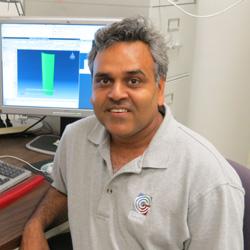
 When it comes to technological advancement, Tajendra Vir Singh sees no limits.
When it comes to technological advancement, Tajendra Vir Singh sees no limits.
“What you think of today becomes reality tomorrow,” Singh said. “Smartphones are an excellent example. In fewer than 20 years the technology has advanced so much that the processor in today’s smartphone is more powerful than the processor of fastest supercomputer of 1994, we carry it in the palm of our hand, and it is shrinking as we speak. And I find that exciting.”
Singh brings this enthusiastic outlook to his role as manager of high-performance computing research and projects at UCLA’s Institute for Digital Research and Education (IDRE), where he oversees the systems and applications groups. These groups support many IDRE programs, including the Hoffman2 Shared Research Cluster, education and training, the pipeline to leadership-class facilities, Extreme Science and Engineering Discovery Environment (XSEDE), and Graphics Processing Unit (GPU)/Many Core.
“My job is to make sure that the programs we employ are good ones, and that they are good for the university,” said Singh, who has worked in the high-performance computing field since completing his Ph.D. in applied mathematics at the Indian Institute of Technology in Delhi in 1993.
Recognizing the importance of providing training and education to Hoffman2 users, IDRE offers several workshops each quarter, with topics ranging from basic to advanced. IDRE also plays a significant role in the pipeline to leadership-class facilities by helping researchers gain access to national supercomputing centers. Singh, who joined IDRE in 2010 after eight years as a high-performance computing consultant in Academic Technology Services, oversees this process. The transition from desktop to a large cluster such as the Hoffman2 to the huge clusters at the national computing labs is complicated. IDRE helps simplify it.
“When we are approached by a user, we find out what is possible within his application so it can run on the [Hoffman2],” Singh said. “Then we do analysis so it can scale upwards to run on the even bigger clusters at the national labs. A bicycle will run for you if you hold the handle and pedal, but if you’re running an airplane you need to know the details of the dashboard. We take those bicycle riders and make them car riders, and then make them pilots so they can run their applications in the big labs.”
XSEDE, which is sponsored by the National Science Foundation, supports 16 supercomputers across the country. Singh and his staff work as the local resource for XSEDE’s Campus Champion Program.
“If there is a need within UCLA for a researcher to use the XSEDE resources, he contacts us and we help him with his training needs,” Singh said. “We help him get started on those resources, working as his local contact.”
The tremendous growth in GPU computing has resulted in a need to adapt algorithms to run existing codes effectively on multi-core processors and many integrated cores. IDRE’s GPU/Many Core program focuses on the porting and design of algorithms to accomplish these goals. For Singh, this is a particularly exciting field. How do you utilize these GPUS and many cores? How do you write programs that can get the most out of your hardware?
“I’ve always been fascinated with number crunching,” he said. “How fast can you do it? These technologies are evolving quickly, and we get something better every year. Our job is to investigate everything new that is coming up. We keep up with the latest technology and make sure users can understand that technology.”
As manager of IDRE’s high-performance computing programs, Singh’s workload is a full one. But when he’s able to catch a break, you’ll likely find him researching new trends.
“I like to read about the latest technologies,” he said. “I like to stay ahead of the technology curve. It’s exciting. -30-